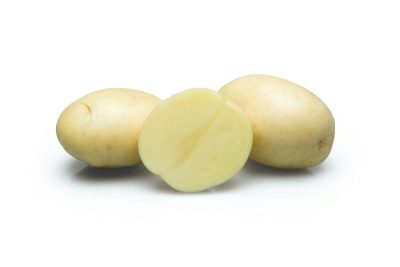
- Authors: Oldenkamp Peter L., Netherlands
- Appeared when crossing: Mondial x Van Gogh
- Name synonyms: Labadia, Labadia
- Year of approval: 2010
- Appointment: dining room
- Tuber size: large
- Tuber weight, g: 100-152
- Peel color: yellow
- Color of the pulp: light yellow
- Starch content,%: 12,2-16,4%
Among the many varieties of potatoes, it is the Dutch varieties that are in great demand, adapting to different climatic conditions, giving stable and high yields. One of the most popular among gardeners and farmers is the mid-early variety Labadia.
Breeding history
Labadia was bred by Dutch scientists of the Step Holland B.V. agricultural complex. The variety is based on the following varieties - Van Gogh and Mondial. The nightshade crop has been approved for use since 2010. Potatoes are zoned in the Central, Volgo-Vyatka, Central Black Earth, Ural, North Caucasian regions.
Description of the variety
Dutch bred potatoes are a tall bush of an intermediate type. The plant is characterized by an erect or semi-erect stem, moderate foliage, large green foliage with weak waviness and a strong root system.
The bushes bloom in the second half of June. During the flowering period, inflorescences appear on potato bushes, consisting of 4-5 snow-white small flowers.
Characteristics of the appearance of the bush and root crops
6-9 large root crops ripen on one bush. The minimum amount of small and non-commercial potatoes. The shape of the tubers is oval, with a smooth surface in smaller tubers, and rough in large vegetables. The color of the potato is uniform - yellow. The peel of the fruit is thin, covered with shallow eyes. On average, tubers weighing from 100 to 152 grams grow on a healthy bush.
Due to the fact that the vegetable is immune to mechanical damage, the dug potatoes can be transported over long distances, as well as stored for a long time in the right conditions at a temperature of 3-4 degrees above zero. To prevent tubers from sprouting during storage, it is necessary to control the moisture level in the cellar or basement.
Purpose and taste of tubers
The Dutch potato tastes good. The pale yellow pulp is endowed with a dense, slightly mealy, oily structure, without a watery aftertaste. During peeling and heat treatment, potatoes do not darken, retaining a creamy yellow tint. The vegetable pulp contains up to 16.5% starch. Potatoes are able to boil moderately.
The table variety is great for frying, baking, making French fries, chips. In addition, the tubers are ideal for mashed potatoes, since boiled potatoes are grain-free. The variety is not suitable for salads and okroshka.
Maturation
Labadia represents a class of mid-early varieties. The growing season lasts about 85 days. Germination and maturation of sprouts and root crops is amicable. The first digging can be done in 70-75 days. The massive harvest takes place in the first half of August.
Yield
The Dutch Labadia potatoes are renowned for their excellent yields. With proper care and favorable weather conditions, an average of 290-460 centners of potatoes can be dug from 1 hectare of plantations. The maximum rate is 583 centners per hectare.
Growing and care
Potatoes are planted in the first half of May, when the air warmed up to a stable + 8 ... 10 degrees. In this case, the soil must also warm up to a depth of 10 cm. It is also important that the spring return frosts are left behind, otherwise the culture will die. As a planting material, medium tubers weighing 100 grams with good sprouts 1-1.5 cm long are selected. Onions, legumes, and garlic will be the best predecessors for the Dutch nightshade culture. It is strictly forbidden to plant potatoes in the place where tomatoes, eggplants or peppers previously grew.The optimal layout for planting is 70x35 cm.
Caring for a nightshade crop consists of a chain of activities: regular watering, high hilling, loosening and weeding of row spacings, fertilizing three times per season, preventing diseases and pest attacks.

Planting potatoes is one of the main spring activities traditional for Russian gardeners. There are many ways to plant this vegetable, allowing you to get a good harvest in different conditions and climates. Before planting, you need to carefully prepare the planting material, correctly determine the timing, competently prepare the soil.


Soil requirements
The culture has no special requirements for the quality of the soil - it is enough for the soil to be nutritious, moist, breathable, with neutral acidity. If the groundwater is shallow, then it is better to plant the tubers on the ridges, since stagnant water can be harmful.

Required climatic conditions
Potatoes are a thermophilic culture that needs moderate moisture, space, and sunny days. In addition, the variety easily tolerates drought, but reacts negatively to cold wind, drafts, dampness, which can cause a number of fungal infections. It is recommended to choose a plot that is flat, free of weeds, well-lit by the sun.
Disease and pest resistance
Labadia is the owner of strong immunity, which helps the plant to resist many fungal and bacterial infections - potato cancer, golden nematode, wrinkled mosaic, leaf curling. Late blight of tubers and leaves is considered the greatest problem for the variety.

Potatoes are a popular vegetable crop that many gardeners planted on their site. But growing a bountiful harvest of tasty and large tubers is unlikely to succeed if the beds are not properly protected from the most common diseases and pests. Often, the development of diseases of various etiologies of potatoes goes unnoticed, so it is important to identify the problem in time and eliminate it.
















































































